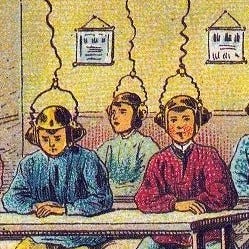Deconstructing Change
As we march toward the end of the semester, we’re rounding out the grab bag of tools that inform how to either anticipate or to create change. One important method to consider is Sohail Inayatullah’s Causal Layered Analysis (CLA). I’ve written before about CLA, in the context of creating visions of preferred futures, but the technique is interesting because it serves both as a description of and prescription for change in society.
The basic concept is to peel back the layers of our observable world to investigate what lies underneath and causes current events to emerge as they do. This is an opinionated model of reality/theory of change1: the events we perceive day-to-day are caused by systems, which are the outcome of worldviews, which are created by the deep and often pre-verbal myths and metaphors of our culture2. We can interrogate a recent change (or something we wish to change) through this lens, working to peel back the layers of reality3 and understanding how these things stack up. This is the descriptive mode. Then, having deconstructed reality sufficiently4, it’s possible to imagine reconstructing something different by building up from different myths to different worldviews, leading to reimagined systems and then different outcomes at the surface (this stack could be the foundation for a scenario, a preferred future, etc). This is a vertical way to do the work, but it’s also possible to do the work more horizontally; for example, redesign a system to create different outcomes, then make sure the worldviews at play would support the new system.
The Futures of Ethics and the Ethics of Futures
Because applied Futures is about how to actively create change in society, ethical issues and considerations frequently arise. This is more than a succession of increasingly absurd trolley problems; Center for Future Consciousness and sci-fi expert Tom Lombardo identifies something like 16 ways of classifying ethical theories (though some of these heavily overlap); for example, whether good and bad are even meaningful categories5, or whether ethical value is self-evident or needs to be thought/reasoned through6.
But theories of change apply to ethics as well. For those who believe in society as an evolutionary process that progresses over time, our sense of ethical reasoning can progress over time as well. For an example, check out this article by Jonathan Peck from the now-shuttered Institute for Alternative Futures. He speaks explicitly about lower and higher levels of ethical development in society, and friction occurring as society evolves from an ethic of competitive achievement to something more collaborative and/or sustainable. Note that this dovetails very nicely with both Rianne Eisler’s ideas about domination vs partnership societies7 and the Swinburne/Slaughter ideas about emerging planetary consciousness I’ve discussed a few times before.
As a very different approach, check out this very pragmatic guide to how change happens by History for Tomorrow author Roman Krznaric for Oxfam. His “rough guide” on pages 31 and 32 are a systematic way of thinking through multiple theoretically distinct explanations for the origin of a particular change, and ultimately settling on what’s most satisfying.
Note that in Noble’s taxonomy, this theory claims that change is endogenous, contingent, socially real, idealistic, subjective, and rational.
Or, to use the more common metaphor, explore the iceberg below the surface.
This word is chosen carefully; this stage of CLA is a thoroughly postmodern approach, with all the risks of creating a crisis of reality and meaning. Try to avoid getting too skeptical about your own omphalos.
The alternative, of course, is that the solemn wise man was right all along.
The fact that the latter question exists in the middle of a 13-page article about different ways people do, in fact, think about these things, seems like a pretty clear answer.
Though Eisler would presumably disagree that this change is evolutionary, since her thesis is that partnership societies have existed throughout human history.



